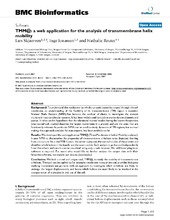| dc.contributor.author | Skjærven, Lars | eng |
| dc.contributor.author | Jonassen, Inge | eng |
| dc.contributor.author | Reuter, Nathalie | eng |
| dc.date.accessioned | 2014-12-05T09:25:52Z | |
| dc.date.available | 2014-12-05T09:25:52Z | |
| dc.date.issued | 2007-07-02 | eng |
| dc.identifier.issn | 1471-2105 | en_US |
| dc.identifier.uri | https://hdl.handle.net/1956/8844 | |
| dc.description.abstract | Background: To understand the mechanism by which a protein transmits a signal through the cell membrane, an understanding of the flexibility of its transmembrane (TM) region is essential. Normal Mode Analysis (NMA) has become the method of choice to investigate the slowest motions in macromolecular systems. It has been widely used to study transmembrane channels and pumps. It relies on the hypothesis that the vibrational normal modes having the lowest frequencies (also named soft modes) describe the largest movements in a protein and are the ones that are functionally relevant. In particular NMA can be used to study dynamics of TM regions, but no tool making this approach available for non-experts, has been available so far. Results: We developed the web-application TMM@ (TransMembrane α-helical Mobility analyzer). It uses NMA to characterize the propensity of transmembrane α-helices to be displaced. Starting from a structure file at the PDB format, the server computes the normal modes of the protein and identifies which helices in the bundle are the most mobile. Each analysis is performed independently from the others and results can be visualized using only a web browser. No additional plug-in or software is required. For users who would like to further analyze the output data with their favourite software, raw results can also be downloaded. Conclusion: We built a novel and unique tool, TMM@, to study the mobility of transmembrane α-helices. The tool can be applied to for example membrane transporters and provides biologists studying transmembrane proteins with an approach to investigate which α-helices are likely to undergo the largest displacements, and hence which helices are most likely to be involved in the transportation of molecules in and out of the cell. | en_US |
| dc.language.iso | eng | eng |
| dc.publisher | BioMed Central | en_US |
| dc.rights | Attribution CC BY | eng |
| dc.rights.uri | http://creativecommons.org/licenses/by/2.0 | eng |
| dc.title | TMM@: a web application for the analysis of transmembrane helix mobility | en_US |
| dc.type | Peer reviewed | |
| dc.type | Journal article | |
| dc.date.updated | 2013-08-28T17:09:25Z | |
| dc.description.version | Peer Reviewed | |
| dc.description.version | publishedVersion | en_US |
| dc.rights.holder | Lars Skjaerven et al.; licensee BioMed Central Ltd. | en_US |
| dc.rights.holder | Copyright 2007 Skjærven et al; licensee BioMed Central Ltd. | en_US |
| dc.source.articlenumber | 232 | |
| dc.identifier.doi | https://doi.org/10.1186/1471-2105-8-232 | |
| dc.identifier.cristin | 474784 | |
| dc.source.journal | BMC Bioinformatics | |
| dc.source.40 | 8 | |

